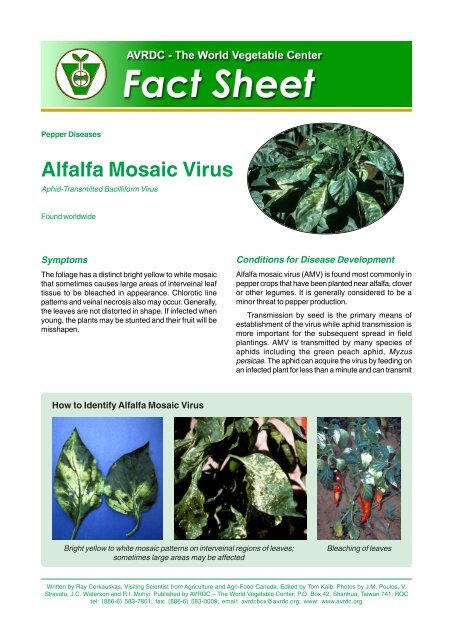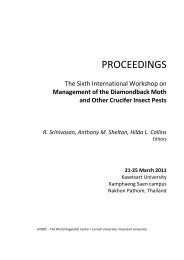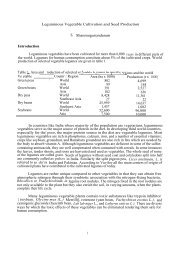You also want an ePaper? Increase the reach of your titles
YUMPU automatically turns print PDFs into web optimized ePapers that Google loves.
<strong>Pepper</strong> Diseases<str<strong>on</strong>g>Alfalfa</str<strong>on</strong>g> <str<strong>on</strong>g>Mosaic</str<strong>on</strong>g> <str<strong>on</strong>g>Virus</str<strong>on</strong>g>Aphid-Transmitted Bacilliform <str<strong>on</strong>g>Virus</str<strong>on</strong>g>Found worldwideSymptomsThe foliage has a distinct bright yellow to white mosaicthat sometimes causes large areas of interveinal leaftissue to be bleached in appearance. Chlorotic linepatterns and veinal necrosis also may occur. Generally,the leaves are not distorted in shape. If infected whenyoung, the plants may be stunted and their fruit will bemisshapen.World Vegetable CenterC<strong>on</strong>diti<strong>on</strong>s for Disease Development<str<strong>on</strong>g>Alfalfa</str<strong>on</strong>g> mosaic virus (<str<strong>on</strong>g>AMV</str<strong>on</strong>g>) is found most comm<strong>on</strong>ly inpepper crops that have been planted near alfalfa, cloveror other legumes. It is generally c<strong>on</strong>sidered to be aminor threat to pepper producti<strong>on</strong>.Transmissi<strong>on</strong> by seed is the primary means ofestablishment of the virus while aphid transmissi<strong>on</strong> ismore important for the subsequent spread in fieldplantings. <str<strong>on</strong>g>AMV</str<strong>on</strong>g> is transmitted by many species ofaphids including the green peach aphid, Myzuspersicae. The aphid can acquire the virus by feeding <strong>on</strong>an infected plant for less than a minute and can transmitHow to Identify <str<strong>on</strong>g>Alfalfa</str<strong>on</strong>g> <str<strong>on</strong>g>Mosaic</str<strong>on</strong>g> <str<strong>on</strong>g>Virus</str<strong>on</strong>g>Bright yellow to white mosaic patterns <strong>on</strong> interveinal regi<strong>on</strong>s of leaves;sometimes large areas may be affectedBleaching of leavesWritten by Ray Cerkauskas, Visiting Scientist from Agriculture and Agri-Food Canada. Edited by Tom Kalb. Photos by J.M. Poulos, V.Stravato, J.C. Waters<strong>on</strong> and R.I. Muhyi. Published by AVRDC – The World Vegetable Center; P.O. Box 42, Shanhua; Taiwan 741; ROCtel: (886-6) 583-7801; fax: (886-6) 583-0009; email: avrdcbox@avrdc.org; www: www.avrdc.org
it as quickly, but the aphid actually retains the virus for<strong>on</strong>ly a short period of time. The virus is also readilytransmitted mechanically and by grafting.C<strong>on</strong>trol<strong>Pepper</strong> varieties resistant to <str<strong>on</strong>g>AMV</str<strong>on</strong>g> are not available.Various c<strong>on</strong>trol measures are required because<str<strong>on</strong>g>AMV</str<strong>on</strong>g> is transmitted by seed, aphids, and mechanically.C<strong>on</strong>trol measures must take into account the disease’swide host range (alfalfa, pepper, tomato, tobacco, potato,clover, many cucurbits and beans, and several othercrops and weeds) and numerous aphid vectors.Use virus-free pepper seed. Check transplants forany symptom development and discard those withsymptoms. One or two transplants <strong>on</strong> either side ofthe affected plants should also be discarded. Avoidtouching or handling healthy plants after handling plantssuspected of virus infecti<strong>on</strong>. Wash hands with soapafterwards or use disposable gloves when handlinginfected plants.<str<strong>on</strong>g>AMV</str<strong>on</strong>g>-infected vegetable seedlings are potentialprimary sources of the virus. Cover seedlings with meshsize of 32 or higher to prevent aphids. Do not clip ordamage young seedlings since this increases thepossibility of mechanical transmissi<strong>on</strong> of the virus fromc<strong>on</strong>taminated tools or hands.Aphid c<strong>on</strong>trol may be difficult because the virus istransmitted very rapidly by these insects. Use fastactinginsecticide sprays since aphids may move toother nearby unsprayed plants when disturbed.Disinfect tools, stakes, and equipment before movingfrom diseased areas to healthy areas. Work in diseasedareas last, after working in unaffected parts of a field.Other less effective measures include: plantingbarrier crops that are not susceptible to <str<strong>on</strong>g>AMV</str<strong>on</strong>g> such ascorn, applying sticky traps, or covering the ground withan aphid deterrent material like aluminum foil strips.Another c<strong>on</strong>trol strategy is to grow trap crops nearbythat attract aphids and then spray these plants with ac<strong>on</strong>tact insecticide to destroy the aphid populati<strong>on</strong>s.Also, spray the pepper crop with mineral oil to delayvirus spread in the field by interfering with aphidtransmissi<strong>on</strong> of the virus.For more informati<strong>on</strong> <strong>on</strong> the producti<strong>on</strong> ofpepper and other vegetables, go to.AVRDC Publicati<strong>on</strong> 04-5902004
















